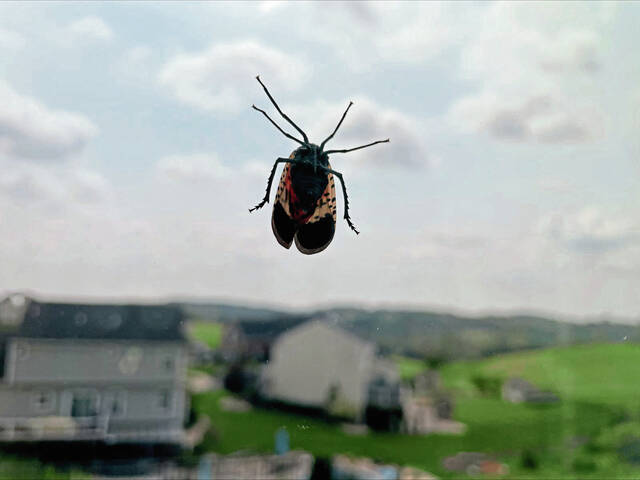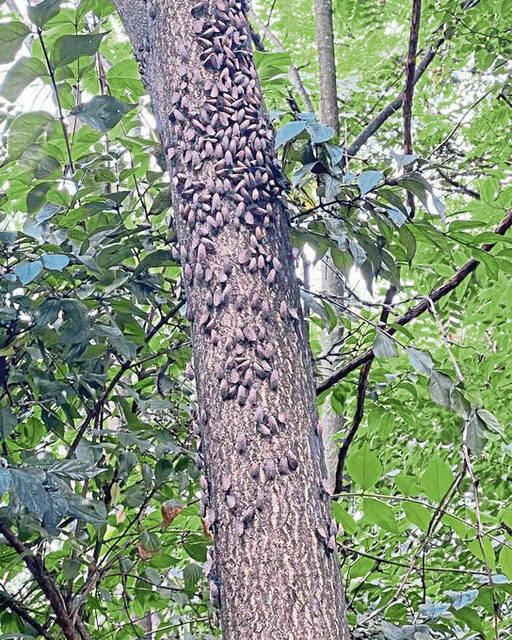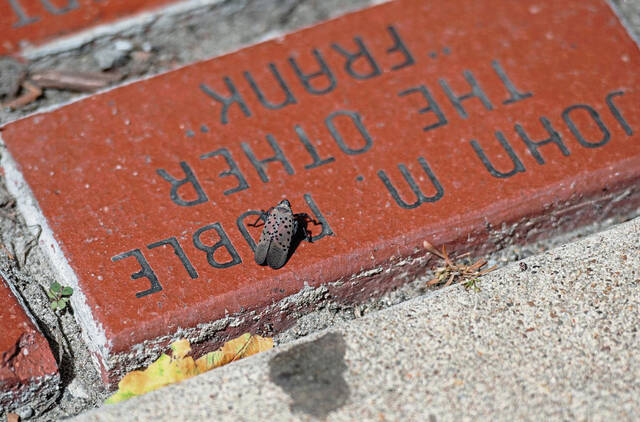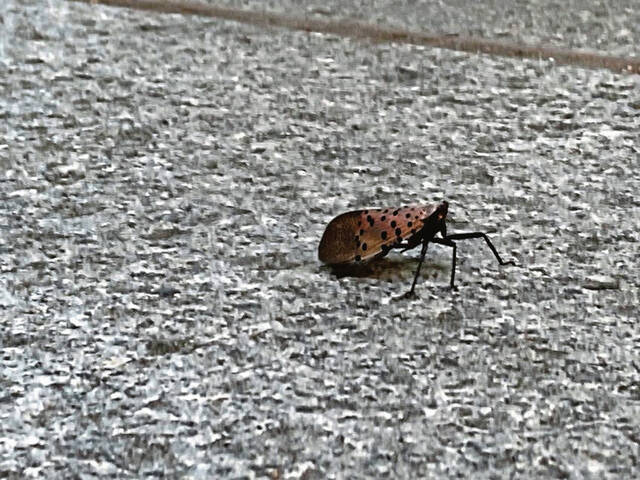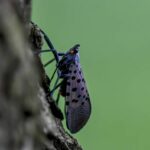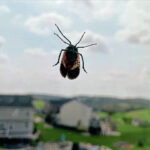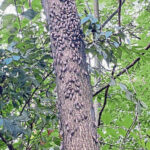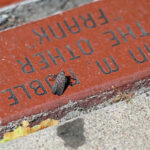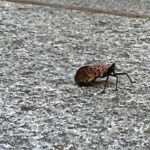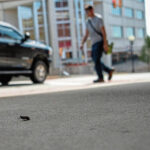When Moshe Marvit got off work in Green Tree this week, he noticed that every single car in the parking lot was covered in spotted lanternflies.
“There were tens of thousands of them in a small space,” said Marvit, a lawyer who lives in Pittsburgh’s Greenfield neighborhood. “It felt like that scene from ‘The Birds’ where the crows just appeared everywhere on the playground.”
And it’s not just at work. Marvit said his back patio is infested with spotted lanternflies, a small invasive insect the size of a quarter with spotted blue and red wings. He said the bugs are awkward flyers and don’t bite, but they just inhabit all of the back porch. This makes sitting outside uncomfortable.
“We can’t use our deck right now. They seem to have no regard for you and no fear of humans,” he said. “We have sort of relegated the back deck to the lanternflies. They have taken over.”
For many residents in Western Pennsylvania, escape from the lanternfly is futile. The invasive species has swarmed trees, exterior walls of coffee shops, personal vehicles and more.
Populations of the insect appear to be peaking in the region.
Jake Milofsky, director of tree care at local nonprofit Tree Pittsburgh, said he has noticed an increase in lanternfly populations in the Pittsburgh area. They have drastically increased over the past few years.
The Tribune-Review received reports of swarms of lanternflies as far east as Monroeville, Murrysville and Greensburg, south to McKeesport, into the North Hills, and are even occupying Kennywood. The city of Pittsburgh has large concentrations, particularly Downtown and the North Shore.
Hard to explain how many Lanternflies there are outside the East Liberty Whole Foods pic.twitter.com/Q4ikbjgVL9
— Stephen Mayhew (@mayhewsw) August 21, 2023
Milofsky said the insects are non-native and the state has encouraged their removal, but their presence in the region, so far, has not destroyed ecosystems. He said there are still many unanswered questions about lanternflies and we should expect to see them in the region moving into the future.
“They are a nuisance, but they are not a catastrophic hazard,” he said.
Invasive, but not dangerous
Spotted lanternflies are native to China and were first discovered in the United States in Berks County, Pa. in 2014, said Sandy Feather of the green industry team at Penn State Extension.
She said the insects were spotted in Western Pennsylvania as early as 2019, but their populations were relatively small and scattered.
This summer, their numbers have grown significantly locally. Feather said 51 out of the state’s 67 counties — including Allegheny and Westmoreland — have been listed under quarantine for spotted lanternflies. She said some northern tier counties have avoided them so far, but she expects the insects to make their way north eventually.
They enter a nymph, flightless stage in early summer, with a black appearance and white spots. By late summer, they grow into adults with the ability to fly and start to swarm trees, telephone poles, buildings, and bridges. By winter, they either migrate away or die from the cold.
Even so, both Feather and Milofsky said increased lanternfly populations shouldn’t raise immediate alarms.
Milofsky said spotted lanternflies pose no danger to humans, they aren’t poisonous and they don’t bite.
The insects do eat vegetation and can decimate grape vines and apple orchards enough to hurt farmers. The state Department of Agriculture website said lanternflies feeding damage stresses plants which can decrease their health and in some cases cause death.
Milofsky said they can damage plants, but homeowners worried about their trees should be less worried.
“They are not a death sentence to a tree,” said Milofsky.
Other invasive insects like emerald ash borers have wiped out tree groves, but Milofsky said lanternflies do not have the same catastrophic effect on trees.
He explained that lanternflies secrete a sugary waste called honeydew, which attracts other insects like bees. When lanternflies congregate in large numbers, the substance can get all over people’s furniture and property, attracting a black fungus that grows in the honeydew. But none of that will kill trees quickly.
“Spotted lanternflies are not going to kill your tree,” he said. “They are going to be gross and drop their honeydew. They will weaken trees, but they are not killing them.”
How did they get to Pittsburgh?
It’s not exactly clear how spotted lanternflies arrived in the Pittsburgh region, but both Feather and Milofsky suspect the insects hitched rides on human transport.
Feather said a friend even recently once found a swarm of lanternflies in the hood of their car.
“I hadn’t planned to scout the hood of my truck before I head home, but now I guess I should,” Feather said.
Derek Haeussler, a sophomore at the University of Pittsburgh, said the laternfly infestation has been particularly bad in Oakland. He has been stomping them when he can, but hopes that state or regional management will increase soon.
“The sidewalks are littered with crushed lanternflies,” he said. “It’s like a warzone.”
Related:
• Show no mercy to the spotted lanternfly• Spotted lanternfly numbers on the rise in Allegheny County
• Get ready to stomp: Spotted lanternflies about to hatch in Western Pennsylvania
Interestingly, lanternflies reports are now less concerning in the southeastern portion of the state, where they were first discovered about 10 years ago.
Pennsylvania Department of Agriculture spokesman Jay Losiewicz said overfeeding by lanternflies in one year may cause the populations to move out of one area and be larger in other areas. He said spotted lanternfly populations have generally been low in areas where the insects were first found in 2014 in Southeastern Pennsylvania.
Whatever the reason, more of the insects appear to be moving into Pittsburgh.
“We are building the population here. It is still pretty new,” said Feather.
Lanternfly management
Jonathan Burgess of Pittsburgh’s Swisshelm Park neighborhood said he has a couple of thousand resident lanternflies in a sycamore tree in his backyard. He said last year he remembers spotting them near bridges and on hillsides, but now he sees them just about everywhere in the city.
He said attempts to eliminate them from his yard haven’t worked, and he is metaphorically “spitting on fire.”
“By the time I realized they were in my sycamore tree, they were at the top,” Burgess said. “Everything I have done since then, it has done nothing.”
Feather said that Pittsburghers shouldn’t panic when they spot lanternflies. She encouraged stomping and said the best way to do so is from the front, since spotted lanternflies can only jump forward.
Burgess said a silver lining to his infestation has been continual entertainment for his 3-year-old daughter, who enjoys smashing them.
Feather said there are other ways to kill lanternflies, including insecticides, but repellants have yet to be discovered. Insecticides are effective but will also likely have damaging effects on native insects, even possibly birds and other small animals.
“She recommends the least-toxic registered insecticides, and to avoid home remedies. That way, lanternflies are killed, but effects on other species are decreased, she said.
Losiewicz said the department of agriculture encourages residents to utilize a trap called a Circle Trap, which can be built with items they may already have in their homes. Penn State Extension has more information on its website about circle traps.
Even though it seems like spotted lanternflies are everywhere now, Losiewicz said the state still wants residents to file reports about lanternfly locations. He said reports help researchers better understand the insect and its movement, which will help the state refine treatment methods for future years.
Feather said lanternfly populations might fluctuate in Pittsburgh, but locals should get used to their presence.
“The truth is, we are just going to be living with these things,” she said. “We are way beyond able to eradicate them.”



